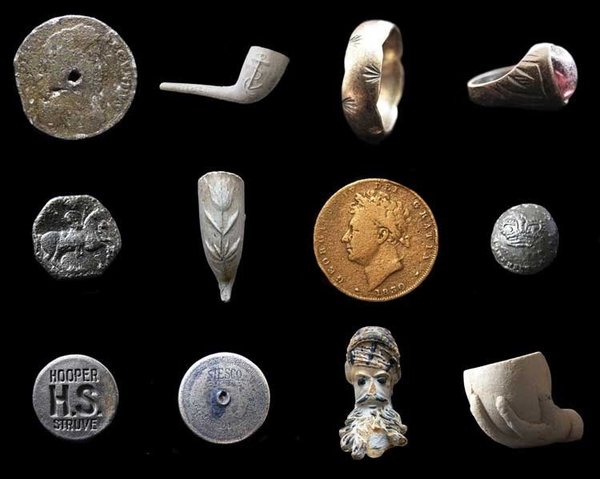npr | by CHRISTOPHER WERTH | April 04, 2013

In the United Kingdom, British archaeologists have made a number of significant discoveries as of late, from the battered remains of King Richard III — found buried beneath a parking lot — to, more recently, a 14th-century burial ground for plague victims in London.
British soil is, in fact, full of traces of the past. And in London, one has to look no farther than the banks of the Thames, the river that runs through the heart of the British capital.
On a brisk, windy morning, Mike Woodham walks the water’s edge in search of things humanity has left behind. His method? A metal-detector that emits a steady beep, beep, beep.

“That’s a strong signal,” Woodham says, bending down. “Let’s give that a little dig and see what we got.”
Woodham belongs to a long London tradition of so-called mudlarks who populate the riverbed when the tide is out. Centuries ago, mudlarks scavenged for bits of coal, scrap iron or other items of value. Today, they’re essentially history buffs who scour the Thames for anything that offers a glimpse into London’s past — the Romans founded London on these banks 2,000 years ago. Since then, the Vikings and Normans have set sail from here. And the Thames was a major thoroughfare of the Industrial Revolution.
Woodham’s digging and scraping yields a small lead token that he recognizes as old ferry fare. He guesses it dates back to around 1550.
“It’s been sitting here for 500 years. That’s what amazes me,” he says. “Like, 500 years ago, someone dropped something and you find it. You can just walk along the ground and find stuff. There’s just been life down here for thousands of years. Nine times out of 10 it’s junk, but that one time it’s something nice. And that’s something we all dig for, that one nice thing.”
And when you find something rare, Woodham says — an Elizabethan coin, a penny that dates back centuries — you ask yourself questions about the person who lost it.
“I think, ‘How did it impact on their life?’ Because if we lose a penny today it means nothing. You know, back in the 1500s a penny was worth quite a lot. So if you lost your wages for that week, how are you going to support your family? That’s what I think about.”
Mudlarks have unearthed all sorts of things in the Thames — from Bronze Age ceremonial objects and 15th-century swords to tiny Roman statuettes and munitions from World War II.
Last year’s “find of the year” was a piece of a 30,000-year-old woolly rhinoceros skull pulled out of the riverbed near London Bridge.
By law, mudlarks need a license to dig on the riverside. And under a voluntary program in the U.K. called the Portable Antiquities Scheme, significant finds are supposed to be reported to the Museum of London, just a short walk from the Thames.
“A lot of the things in the gallery have come from the river,” says Roy Stephenson, the manager of the archaeological archives.
Stephenson says mudlarks’ discoveries help fill gaps in the museum’s collection. That’s because, on land, metal objects were often melted down and reused. But if something fell in the river, it essentially vanished.
As a result, Stephenson says much of what’s known about, for example, childhood in medieval London, comes from pewter toys lost in the Thames centuries ago and found by mudlarks today.
“There’s little lidded jugs, little pewter plates,” Stephenson says, pointing out objects in a display case. “You know, if you were a kid, these are the pocket money toys of the day. We are getting to see some absolutely fascinating things that come off the foreshore.”
But not everyone is thrilled with the work of the mudlarks. They’re allowed to dig roughly 4 feet into the banks of the Thames — and that’s angered archaeologists like Paul Barford. He says all that digging has destroyed the centuries-old layers of earth in which artifacts are buried and which helps give them a historical context.
“The foreshore of London has been so thoroughly dug over, and so deeply, that I doubt there’s very much archaeology left there,” Barford says. “Any archaeological layers, any archaeological deposits that were there, they’ve gone. We’ve lost it because of these mudlarks.”
Today, Barford says, that same destruction is happening on land — at important archaeological sites all over Britain. He believes more than 11 million artifacts have gone unreported by hobbyists with metal detectors over the past several decades.
Many of these objects end up in private collections or for sale online. Barford says he recently spotted a pair of Anglo-Saxon gold rings on eBay. This is why he wants tougher restrictions on metal detecting in the U.K.
“Britain is the only country which does this,” Barford says. “All the other countries of Europe, like Poland or France, if you go out with a spade you could get locked up for it. And in England they pat you on the head and say, ‘Thank you. Well done for digging a big hole in this archaeological site and bringing us these lovely coins.’ People just do not understand that with this goes a wholesale destruction of the archaeological record.”
It is best if “detectorists” just pick up what’s on the ground, instead of digging for finds, says Roy Stephenson at the Museum of London. He admits the British system has its flaws, but he believes it does work to some extent.
“We don’t know what isn’t coming to us, so you know there’ll be a portion of that picture that we’re not seeing,” Stephenson says. “But we’re not losing everything. We’re seeing quite a lot of it, and some of it we’re keeping for our collections and for sound academic study as well.”
On the banks of the Thames, Woodham is still looking for that one nice thing.
“Archaeologists say metal detecting is bad, and metal detectorists say archaeologists are bad,” Woodham says. “They don’t like us being here because they don’t see us as professional. But I personally think they’re just misinformed. All we’re doing is helping them by finding stuff. So in a way we are archaeologists as well. If they respect me, I respect them.”
And with that, Woodham calls it a day. The tide has begun to creep back over the riverbank. The Thames rises and falls more than 20 feet, twice a day, just as it’s done for thousands of years.



